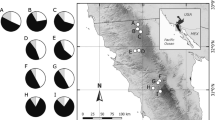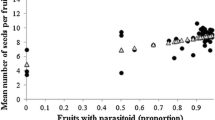Abstract
Few studies have simultaneously addressed the effects of biotic and abiotic factors on pre-dispersal seed predation (PSP). Plant–seed predator interactions may be influenced by natural enemies and pollinators (the latter through changes in fruit or seed traits), and the activity of pre-dispersal seed predators and their natural enemies may both be affected by the abiotic environment. Additionally, in the case of cleistogamous plants with fruit dimorphism, PSP may be biased towards larger and more seeded chasmogamous (CH) fruits [relative to the smaller cleistogamous (CL) fruits], and the effects of biotic and abiotic factors may be contingent upon this fruit dimorphism. We studied PSP in the cleistogamous Ruellia nudiflora using a split-plot experimental design and asked the following: (1) is PSP biased towards CH fruits and is there an effect of pollen load on PSP? (2) Do parasitoids influence PSP and is their effect influenced by pollen load or fruit type? And (3) do light and water availability modify PSP and parasitoid effects? PSP was higher for CH relative to CL fruits, and under low water availability it was lower for pollen-supplemented CH fruits relative to open-pollinated CH fruits. Parasitoids were not influenced by abiotic conditions, but their negative effect on PSP was stronger for pollen-supplemented CH fruits. Overall, we show that fruit dimorphism, abiotic factors and natural enemies affect PSP, and that these effects can be non-additive.




Similar content being viewed by others
References
Abdala-Roberts L, Parra-Tabla V, Salinas-Peba L, Herrera CM (2009) Noncorrelated effects of seed predation and pollination on the perennial herb Ruellia nudiflora remain spatially consistent. Biol J Linn Soc 96:800–807
Abdala-Roberts L, Parra-Tabla V, Salinas-Peba L, Diaz-Castelazo C, Delfín-González H (2010) Spatial variation in the strength of a trophic cascade involving Ruellia nudiflora (Acanthaceae), and insect seed predator and associated parasitoid fauna in Mexico. Biotropica 42:180–187
Ashman T-L (2002) The role of herbivores in the evolution of separate sexes from hermaphroditism. Ecology 83:1175–1184
Campbell CS, Quinn JA, Cheplick GP, Bell TJ (1983) Cleistogamy in grasses. Annu Rev Ecol Syst 14:411–441
Cariveau D, Irwin RE, Brody AK, Garcia-Mayeya LS, von-der-Ohe A (2004) Direct and indirect effects of pollinators and seed predators to selection on plant and floral traits. Oikos 104:15–26
Chico-Ponce de León PA (1999) Atlas de procesos territoriales. Universidad Autónoma de Yucatán, Mérida
Crawley MJ (1992) Seed predators and plant population dynamics. In: Fenner M (ed) Seeds: the ecology of regeneration in plant communities. CAB International, Oxford, pp 157–191
Crawley MJ (2007) The R book. Wiley, Chichester
Culley TM, Klooster MR (2007) The cleistogamous breeding system: a review of its frequency, evolution, and ecology in angiosperms. Bot Rev 73:1–30
Díaz-Fleischer F, Aluja M (2003) Influence of conspecific presence, experience and host quality on oviposition behavior and clutch size determination in Anastrepha ludens (Diptera: Tephritidae). J Insect Behav 16:537–554
Dicke M, Sabelis MW (1988) Infochemical terminology: based on cost-benefit analysis rather than origin of compounds? Funct Ecol 2:131–139
Dicke M, Vet LEM (1999) Plant–carnivore interactions: evolutionary and ecological consequences for plant, herbivore and carnivore. In: Olff H, Brown VK, Drent RH (eds) Herbivores: between plants and predators. The 38th Symposium of the British Ecological Society. Blackwell Science, Oxford, pp 483–520
Dogterom M, Winston ML, Mukai A (2000) Effect of pollen load size and source (self, cross) on seed and fruit production in highbush blue berry cv. “Bluecrop” (Vaccinium corymbosum; Ericaceae). Am J Bot 87:1584–1591
Ehrlén J, Käck S, Ågren J (2002) Pollen limitation, seed predation and scape length in Primula farinosa. Oikos 97:45–51
Flores S, Espejel I (1994) Tipos de vegetación de la península de Yucatán. In: Flores S (ed) Etnoflora yucatanense. Universidad Autónoma de Yucatán, Mérida, pp 63–70
Gómez JM, Zamora R (1994) Top-down effects in a tritrophic system: parasitoids enhance plant fitness. Ecology 75:1023–1030
Goodwillie C, Kalisz S, Eckert CG (2005) The evolutionary enigma of mixed mating systems in plants: occurrence, theoretical explanations, and empirical evidence. Annu Rev Ecol Syst 36:47–79
Hawkins BA, Cornell HV, Hochberg ME (1997) Predators, parasitoids, and pathogens as mortality agents in phytophagous insect populations. Ecology 78:2145–2152
Herrera CM (2000) Measuring the effects of pollinators and herbivores: evidence for non-additivity in a perennial herb. Ecology 81:2170–2176
Knight TM, Steets JA, Vamosi JC, Mazer SJ, Burd M, Campbell DR, Dudash MR, Johnston M, Mitchell RJ, Ashman T-L (2005) Pollen limitation of plant reproduction: ecological and evolutionary causes and consequences. Annu Rev Ecol Syst 36:467–497
Knight TM, Steets JA, Ashman T-L (2006) A quantitative synthesis of pollen supplementation experiments highlights the contribution of resource reallocation to estimates of pollen limitation. Am J Bot 93:271–277
Kolb A, Ehrlén J (2010) Environmental context drives seed predator-mediated selection on a floral display trait. Evol Ecol 24:433–445
Kolb A, Ehrlén J, Eriksson O (2007) Ecological and evolutionary consequences of spatial and temporal variation in pre-dispersal seed predation. Perspect Plant Ecol 9:79–100
Leimu R, Syrjänen K, Ehrlén J, Lehtilä K (2002) Pre-dispersal seed predation in Primula veris: among-population variation in damage intensity and selection on flower number. Oecologia 133:510–516
Long RW (1977) Artificial induction of obligate cleistogamy in species-hybrid in Ruellia (Acanthaceae). B Torrey Bot Club 104:53–56
Louda SM (1982) Distribution ecology: variation in plant recruitment over a gradient in relation to insect seed predation. Ecol Monogr 52:25–41
Marrufo D (2011) Variación espacial en la hercogamia y tasa de entrecruzamiento poblacional en Ruellia nudiflora (Acanthaceae) en la península de Yucatán. Master thesis, Universidad Autónoma de Yucatán, Mérida
Marshall M, Ganders FR (2001) Sex-biased seed predation and the maintenance of females in a gynodioecious plant. Am J Bot 88:1437–1443
Morris MG (1991) Weevils. In: Naturalists’ handbooks, vol 16. Slough, Richmond
Munguía-Rosas MA, Parra-Tabla V, Ollerton J, Cervera JC (2012) Environmental control of reproductive phenology and the effect of pollen supplementation on resource allocation in the cleistogamous weed, Ruellia nudiflora (Acanthaceae). Ann Bot 109:343–350
Oakley CG, Maruichi KS, Winn AA (2007) The maintenance of outcrossing in predominantly selfing species: ideas and evidence from cleistogamous species. Annu Rev Ecol Syst 38:437–457
Ortegón-Campos I (2010) Adaptación local y diversidad genética de Ruellia nudiflora (Acanthaceae) en el estado de Yucatán. PhD dissertation, Universidad Autónoma de Yucatán, Mérida
Ortegón-Campos I, Parra-Tabla V, Abdala-Roberts L, Herrera CM (2009) Local adaptation of Ruellia nudiflora (Acanthaceae) to biotic counterparts: complex scenarios when two herbivore gilds are considered. J Evol Biol 22:2288–2297
Östergård H, Hambäck PA, Ehrlén J (2007) Pre-dispersal seed predation: the role of fruit abortion and selective oviposition. Ecology 88:2959–2965
Pinheiro CJ, Bates D (2000) Mixed-effect models in S and S-PLUS. Springer, New York
Polis GA, Swears ALW, Huxel GR, Strong DR, Maron J (2000) When is a trophic cascade a trophic cascade? Trends Ecol Evol 15:473–475
Price PW (1984) Insect ecology, 2nd edn. Wiley Interscience, New York
R Development Core Team (2009) R: a language and environment for statistical computing. R Foundation for Statistical Computing, Vienna
Schoen DJ, Lloyd DG (1984) The selection of cleistogamy and heteromorphic diaspores. Biol J Linn Soc 23:303–322
Sharma S, Amritphale D (2008) Influence of fruit traits on the infestation of Dacus persicus in two fruit morphs of Calotropis procera. Arthropod Plant Interact 2:153–161
Standley P, Williams L, Gibson D (1974) Acanthaceae in flora of Guatemala. Fieldiana Bot 24:328–462
Traveset A (1991) Pre-dispersal seed predation in Central American Acacia farnesiana: factors affecting the abundance of co-occurring bruchid beetles. Oecologia 87:570–576
Vallejo-Marín M, Dominguez CA, Dirzo R (2006) Simulated seed predation reveals a variety of germination response of Neotropical rain forest species. Am J Bot 93:369–376
Venables WN, Ripley BD (2002) Modern applied statistics with S. Springer, New York
Whitney KD, Stanton M (2004) Insect seed predators as novel agents of selection on fruit color. Ecology 85:2153–2160
Winsor JA, Davis LE, Stephenson AG (1987) The relationship between pollen load and fruit maturation and the effect of pollen load on offspring vigor in Cucurbita pepo. Am Nat 129:643–656
Acknowledgments
This study was financially supported by CONACYT as part of a grant given to V. P. T. (SEP-2004-CO1-4658A/A1). The first author thanks PROMEP for a fellowship given during his stay at the UADY. The authors also thank L. Aldana for access to his property and logistic support. S. Mendoza, P. Tellez, N. Celaya, J. M. Pech-Canché, M. E. Jacome-Flores and B. Torales-Herrera provided field-work assistance. Several undergraduate students also helped with laboratory work. I. Ortegón-Campos, L. Salinas-Peba and D. Marrufo shared advice with regards to the study system and methods. The experiments comply with the current laws of the country (Mexico) in which the experiments were performed.
Author information
Authors and Affiliations
Corresponding author
Additional information
Communicated by Jon Ågren.
Rights and permissions
About this article
Cite this article
Munguía-Rosas, M.A., Abdala-Roberts, L. & Parra-Tabla, V. Effects of pollen load, parasitoids and the environment on pre-dispersal seed predation in the cleistogamous Ruellia nudiflora . Oecologia 173, 871–880 (2013). https://doi.org/10.1007/s00442-013-2649-0
Received:
Accepted:
Published:
Issue Date:
DOI: https://doi.org/10.1007/s00442-013-2649-0




